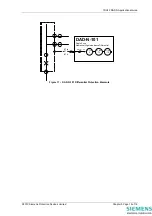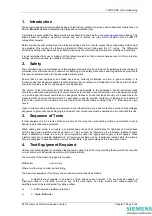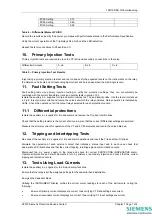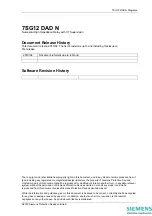
7SG12 DAD N Commissioning
1. Introduction
These commissioning recommendations apply to the testing, putting into service and subsequent maintenance of
DAD-N (
Modular II)
series integrated High Impedance protection relay.
A software program called Reydisp Evolution is available for download from the
website. This
allows access to settings, waveform records and event records via relay communications with an IBM PC
compatible computer.
Before starting the test procedures, the protection settings, the D.C. inputs, output relay configuration details must
be available. This requires the following information: Plant current rating and the C.T. ratios. The Differential
protections setting must also have been determined using the calculated performance for stability and sensitivity.
It is recommended that use is made of all the tables provided so that a comprehensive record of the protection
settings, as commissioned, is available for reference.
2. Safety
The commissioning and maintenance of this equipment should only be carried out by skilled personnel trained in
protective relay maintenance and capable of observing all the safety precautions and Regulations appropriate to
this type of equipment and also the associated primary plant.
Ensure that all test equipment and leads have been correctly maintained and are in good condition. It is
recommended that all power supplies to test equipment be connected via a Residual Current Device (RCD) which
should be located as close to the supply source as possible.
The choice of test instrument and test leads must be appropriate to the application. Fused instrument leads
should be used when measurements of power sources are involved, since the selection of an inappropriate range
on a multi-range instrument could lead to a dangerous flashover. Fused test leads should not be used where the
measurement of a current transformer (C.T.) secondary current is involved, the failure or blowing of an instrument
fuse or the operation of an instrument cut-out could cause the secondary winding of the C.T. to become an open
circuit.
Open circuit secondary windings on energised current transformers are a hazard that can produce high voltages
dangerous to personnel and damaging to equipment, test procedures must be devised so as to eliminate this risk.
3. Sequence of Tests
If other equipment is to be tested at the same time as the relay, then such testing must be co-ordinated to avoid
danger to personnel and equipment.
When cabling and wiring is complete, a comprehensive check of all terminations for tightness and compliance
with the approved diagrams must be carried out. This can then be followed by the insulation resistance tests,
which if satisfactory allows the wiring to be energised by either the appropriate supply or test supplies. When
injection tests are completed satisfactorily, all remaining systems can be functionally tested before the primary
circuit is energised. Some circuits may require further tests, e.g synchronising before being put on load.
4. Test Equipment Required
Various test sets designed for protection testing can be used to test the relay providing these provide the required
current source with sinusoidal waveform within practical limits.
Test currents of the following range are required:
Differential
up to 2.5 xI
N
Where I
N
is the relay nominal current rating.
The basic test equipment for primary and secondary injection test is as follows:
a)
A digital test set capable of at least 2 x three phase current injection. The set must be capable of
injecting at least 4 x the rated current on any of the relay inputs. For relay models with voltage inputs the
amplifiers need to be reconfigured for voltage output.
b)
1 - 500V insulation resistance test set.
c)
1 – Digital Multimeter
©2010 Siemens Protection Devices Limited
Chapter 7 Page 3 of 8
Summary of Contents for 7SG12 DAD-N
Page 2: ......





























